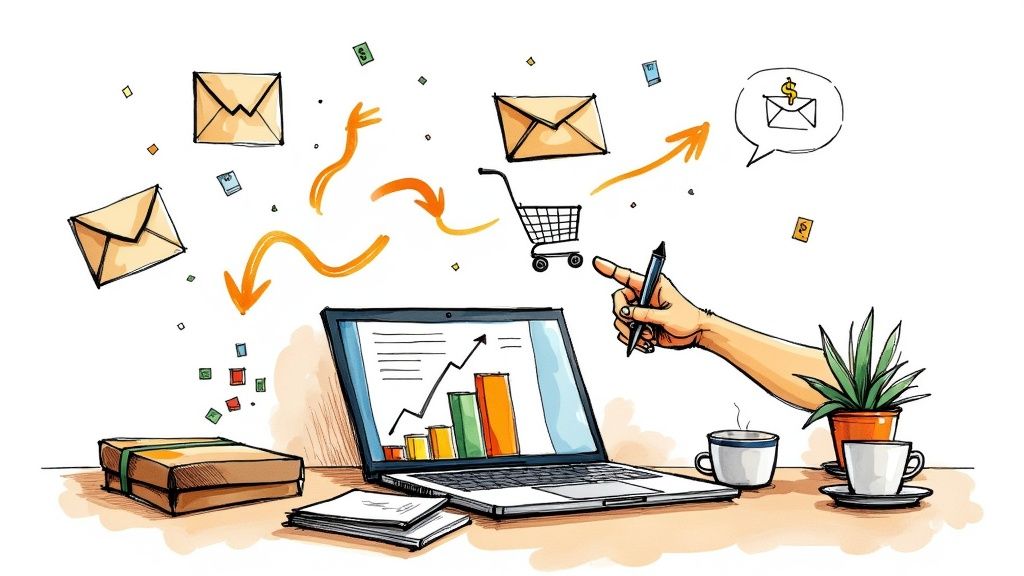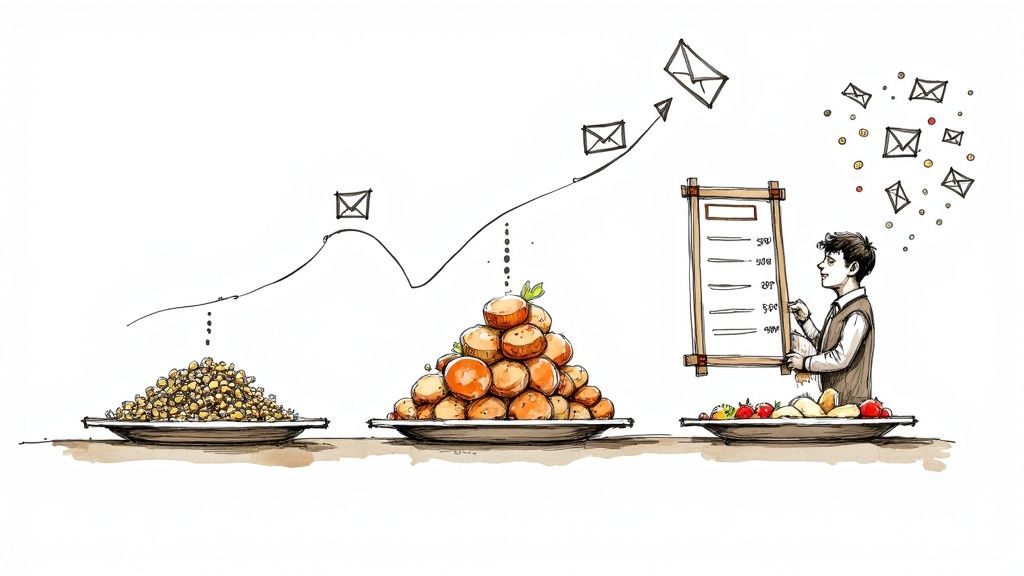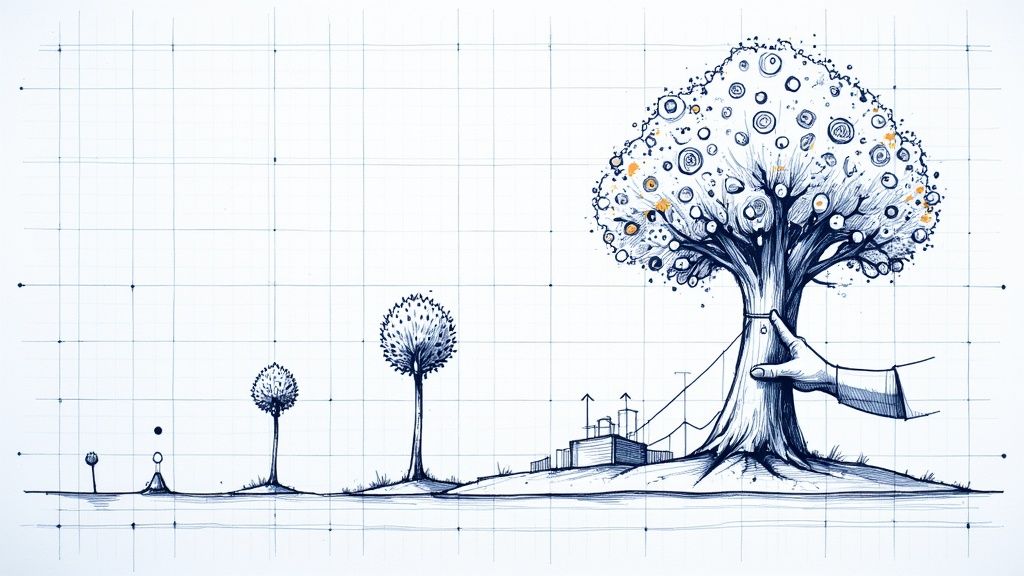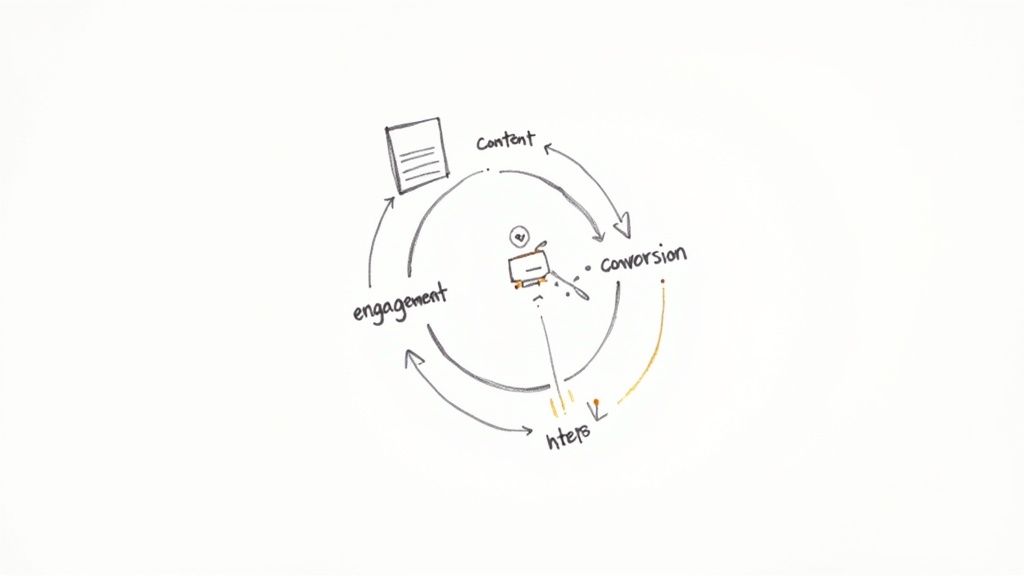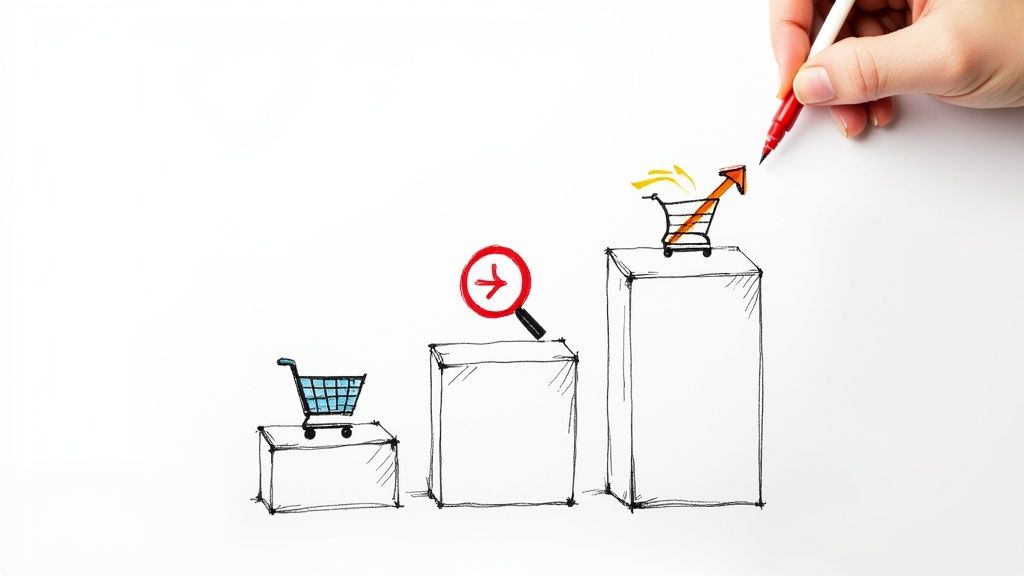How to Increase Average Order Value: Top Tips to Boost Sales
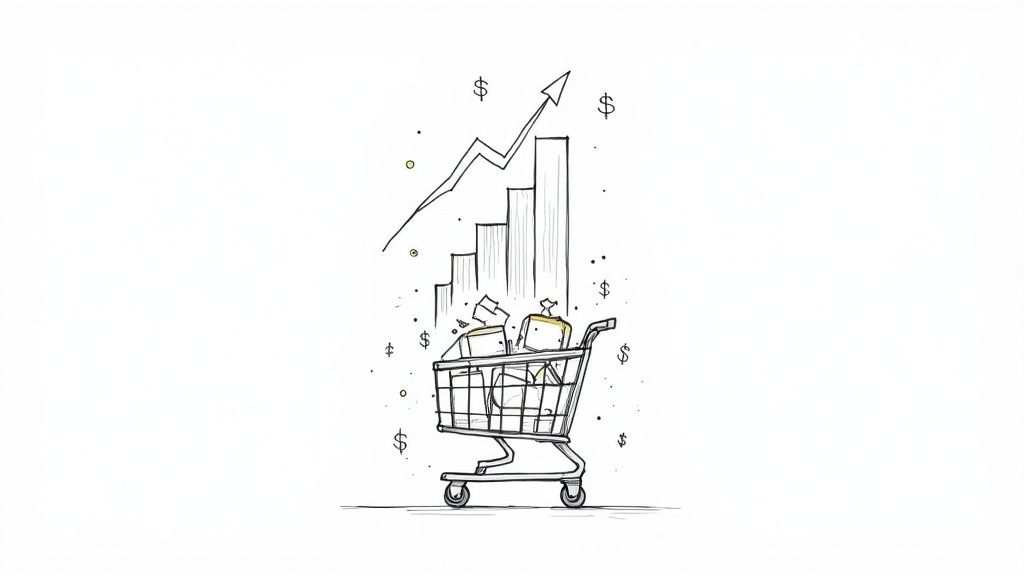
12 mins
5/30/2025
Joe Ervin
- how to increase average order value
- AOV tactics
- boost sales
- revenue growth
- ecommerce strategy
Why Average Order Value Matters More Than You Think
Average order value (AOV) represents the average amount a customer spends on a single purchase. This metric is fundamental to business growth. Increasing your AOV means generating more revenue from existing customers, which is often more cost-effective than acquiring new ones. Smart businesses prioritize AOV.
For example, imagine selling 100 shirts monthly at $20 each, resulting in $2,000 in revenue. A mere $5 increase in AOV to $25 boosts monthly revenue to $2,500, a $500 increase! This illustrates how small AOV adjustments yield significant profit gains.
Increasing AOV is vital for ecommerce businesses. It directly impacts revenue without the need to acquire more customers. As of November 2024, the global AOV was approximately $144.57, an 8.7% year-over-year increase. Learn more about these statistics: https://www.oberlo.com/statistics/average-order-value
Why Focus on AOV Instead of New Customers?
Acquiring new customers involves substantial expenses, including advertising and marketing. However, encouraging existing customers to spend a bit more is often simpler. This allows for faster business growth by concentrating on AOV. It's like extracting more juice from the oranges you already possess, rather than buying more.
Furthermore, satisfied customers who spend more tend to become repeat buyers. They also recommend your store to others, generating valuable word-of-mouth marketing that surpasses any advertisement. Boosting AOV cultivates a robust business with a loyal customer base.
Bundle Products That Customers Actually Want
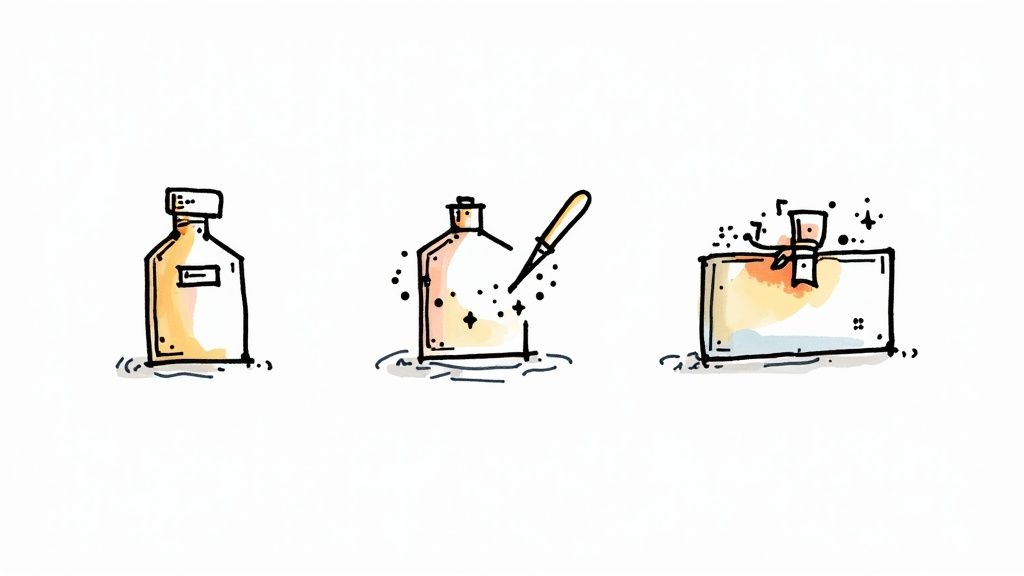
Product bundles can significantly increase your average order value (AOV) when implemented effectively. The core principle lies in grouping complementary items that naturally fit together, much like the classic pairing of peanut butter and jelly, or shampoo and conditioner. These combinations resonate with customers because they fulfill a combined need.
Types of Product Bundles
Several bundle types have proven successful in boosting sales. Here are three examples:
Starter Packs: These bundles provide a convenient entry point for new customers by offering a basic set of related products. A skincare starter pack containing a cleanser, toner, and moisturizer illustrates this concept perfectly.
Upgrade Bundles: An upgrade bundle elevates a core product by including relevant add-ons that enhance its value. For instance, a camera bundle might feature a high-quality lens and a protective carrying case.
Complete Solutions: These comprehensive bundles provide everything a customer needs for a specific activity or project. Imagine a complete grilling set, equipped with tools, spices, and sauces – a one-stop shop for the grilling enthusiast.
These bundles offer a streamlined shopping experience, saving customers both time and money. This convenience translates to increased customer satisfaction and a more enjoyable purchasing process.
Bundle Pricing Strategies
Effective bundle pricing should convey a sense of value to the customer. Offering a discount compared to purchasing each item individually is a common and effective strategy. Even small adjustments to your bundle composition can yield significant results. Some businesses have witnessed a 30% or more increase in orders simply by optimizing their product bundles.
The Psychology of Bundling
The effectiveness of bundling stems from our inherent desire for convenience and value. Bundling also creates a perception of completeness, leading to greater purchase satisfaction. This sense of completion also empowers customers to immediately begin using the products. Presenting bundles in a visually appealing manner is crucial. Clearly highlighting the value proposition and explaining the benefits upfront can significantly influence a customer's decision to add the entire bundle to their cart.
Show Premium Options That Sell Themselves

Premium products can quickly increase your average order value (AOV). The key is understanding when and where to present these options. Imagine offering a customer a larger scoop of ice cream – they might not have initially considered it, but the added indulgence is often worth a small price increase. This section will guide you on how to effectively present higher-priced items, ensuring they feel worth the investment.
Making Premium Products Appealing
Effective upselling focuses on enhancing the customer's experience, not just pushing extra products. It's about demonstrating the added value of a premium choice.
For example, a customer purchasing running shoes might appreciate the suggestion of premium insoles for additional comfort and support. This directly improves their overall experience, justifying the extra cost.
To boost your AOV, combine premium product offerings with targeted marketing. Positioning high-value items alongside standard options can encourage larger purchases. This tactic works particularly well in luxury markets. The average order value for luxury goods like jewelry reached $326 last year. Find more detailed statistics here: https://www.oberlo.com/statistics/average-order-value
Where to Upsell on Your Site
Strategic placement of upsells throughout your website is crucial. Let's explore some key areas:
Product Pages: Suggest upgrades or related premium items. Showcasing a "better" version of what the customer is already viewing is often highly effective.
Cart Pages: This is an ideal location to offer complementary add-ons. Consider this the last chance to enhance their purchase before they proceed to checkout.
Checkout Page: Even at the final stage, a small, relevant premium offer, such as an extended warranty or expedited shipping, can boost AOV.
Each placement requires a tailored approach. A product page upsell might compare features, while a checkout offer could emphasize speed and convenience. Adjusting your approach based on the buying stage ensures a natural and helpful experience.
Training Your Team to Upsell
Equipping your sales team with effective upselling techniques is vital. Train them to focus on the benefits of a premium product, not just its features.
Instead of saying, "This premium version has more memory," encourage them to say, "This extra memory allows you to store thousands more photos without slowing down your phone.” Focus on language that communicates value and directly addresses customer needs. This approach frames upselling as a helpful service, not a pushy sales tactic.
Target Customers Based On Location And Device
Knowing where your customers live and what devices they use to shop online can significantly impact your average order value (AOV). Understanding these factors helps you make smarter decisions to boost your sales. This section explores the influence of location and device type on spending and how you can use this information to your advantage.
Location-Based Strategies
Shopping habits differ significantly across various regions. What works in one market might not resonate in another. Even small adjustments to your product offerings and marketing campaigns can yield substantial results. For instance, consider the popularity of different payment methods in certain areas. Average order values by region show a considerable difference: the Americas boast a much higher AOV at $266, while Asia sits at $130 and Europe, the Middle East, and Africa at $117. Tailoring your approach to individual markets is crucial for maximizing AOV in each region. This can include adjusting pricing, promotions, and even product selection to better suit local preferences. How to master marketing automation for ecommerce provides further insights into optimizing your strategies.
Optimizing for Device Type
The device a customer uses – phone, tablet, or computer – also influences their spending. Generally, desktop users tend to spend more than mobile users ($182 vs. $173 on average). This highlights the importance of a user-friendly desktop website experience. While optimizing for desktop is key, don't neglect mobile users. Ensure your website is responsive and functions seamlessly across all devices, but prioritize the desktop experience for potentially higher AOV.
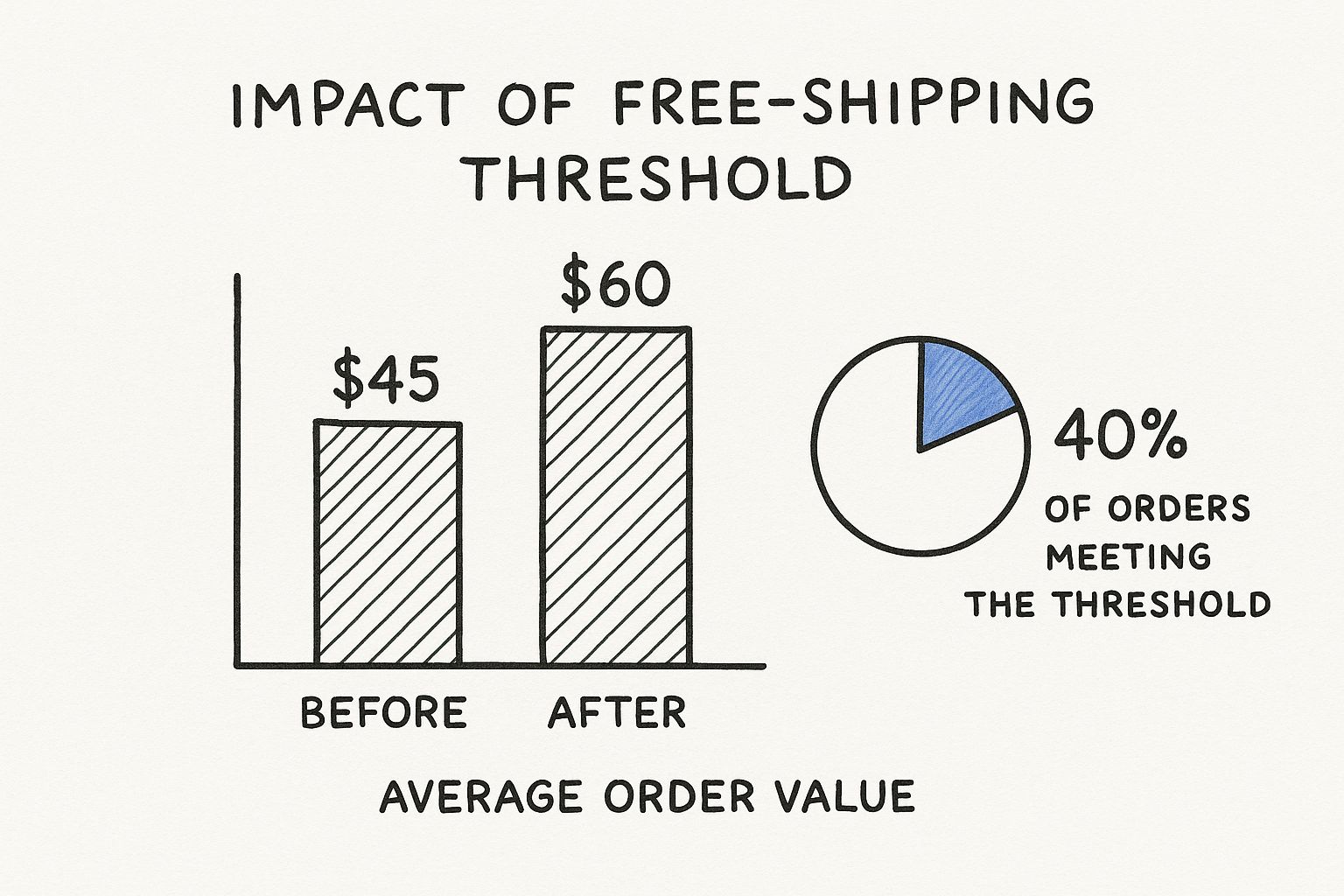
This infographic showcases the impact of a free shipping threshold on AOV. It compares average order values before and after implementing the threshold and illustrates how many orders met it. Raising the free shipping threshold from $45 to $60 resulted in a notable AOV increase. Although only 40% of orders met the higher threshold, the increased spending from those customers significantly boosted the overall AOV. This demonstrates how seemingly minor adjustments can dramatically improve sales performance.
Combining Location and Device Data
Consider the combined effect of location and device. You might find, for example, that mobile shoppers in one country outspend desktop users in another. Identifying these patterns allows for more targeted and effective strategies. Understanding these nuances helps you create specific tactics for AOV growth across all customer segments.
To illustrate the potential of combining location and device data for targeted optimization, let's consider the following table:
AOV by Region and Device Comparison
Comparison of average order values across different regions and device types to help optimize targeting strategies
| Region/Device | Average Order Value | Optimization Opportunity |
|---|---|---|
| Americas (Desktop) | $300 | Offer premium bundles and exclusive deals |
| Americas (Mobile) | $230 | Optimize mobile checkout for speed and convenience |
| Asia (Desktop) | $150 | Highlight value-based offers and promotions |
| Asia (Mobile) | $110 | Implement mobile-first marketing campaigns |
| Europe (Desktop) | $130 | Focus on personalized product recommendations |
| Europe (Mobile) | $100 | Offer free shipping or other incentives for mobile purchases |
This table provides a hypothetical example of how AOV might vary. By analyzing this kind of data, you can pinpoint customer segments with the highest AOV potential and focus your efforts accordingly. For instance, you could offer special promotions or bundled deals to desktop users in high-AOV regions like the Americas. This targeted approach can maximize your return on investment. By focusing on the specific needs and behaviors of each segment, you can tailor your strategies for optimal results.
B2B Tactics That Drive Bigger Orders
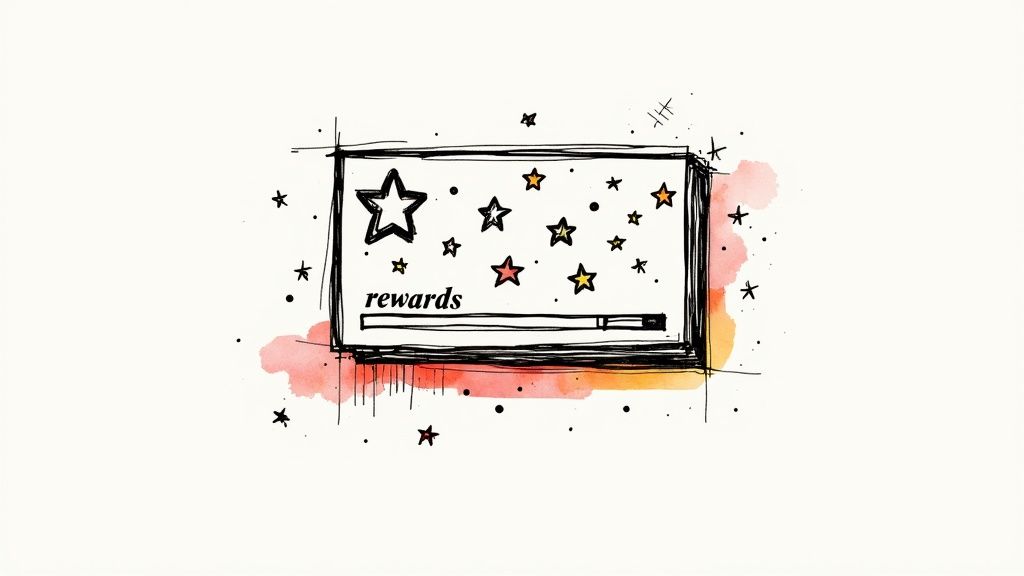
Business-to-business (B2B) customers have different purchasing habits than individual consumers. They often buy in larger quantities and prioritize building strong, long-term relationships. This section explores proven B2B tactics that can effectively increase your average order value.
Volume Discounts
Volume discounts are a tried-and-true method for encouraging larger orders. Similar to buying in bulk at a wholesale store, the more a B2B customer purchases, the lower the per-unit cost. This incentivizes higher spending.
A well-structured pricing model can significantly impact order sizes. For example, consider offering a 5% discount on orders exceeding $1,000 and a 10% discount on orders over $5,000. These tiered discounts motivate customers to reach the next spending threshold to maximize their savings.
Personalized Service
Personalized service is paramount in the B2B world. Nurturing strong relationships with clients often translates to increased sales over the long term.
Make each customer feel valued and understood. By offering tailored solutions that precisely address their specific needs, you can cultivate trust and loyalty. This approach can transform one-time buyers into long-term partners. Dedicated account management can further strengthen these relationships by providing personalized support and expertise.
Smooth and Fast Purchasing
A seamless and efficient purchasing experience is crucial for B2B customers. Eliminating any friction in the sales process, from website navigation to checkout, can significantly improve customer satisfaction and encourage repeat business.
Ensure your website is user-friendly and the checkout process is quick and intuitive. Providing a variety of payment options also enhances convenience. A smooth experience minimizes frustration and increases the likelihood of customers completing their purchases, thus reducing cart abandonment rates and boosting AOV. For inspiration, check out these Examples of Successful Customer Loyalty Programs.
Building Long-Term Relationships
In B2B sales, relationships are key. Taking the time to understand your customers' needs and offering support beyond the initial sale builds trust and fosters long-term partnerships. This approach can significantly impact order sizes over time.
Historically, B2B ecommerce orders have maintained an average order value between 1200-1300 euros. However, strategic relationship-building has shown to dramatically increase this figure. For instance, in March 2022, the B2B average order value experienced a remarkable 42% increase compared to the previous month. You can delve deeper into these B2B order value trends. These strong relationships transform individual transactions into ongoing partnerships, leading to repeat business and consistent growth in average order value.
Build Loyalty Programs That Boost Spending Per Visit
Smart loyalty programs encourage customers to spend more on each visit. The best programs reward higher spending, not just frequent visits. This section explores how to design programs that increase your average order value (AOV) immediately.
Points Systems That Drive Bigger Orders
Points systems can motivate bigger purchases if structured strategically. Think of it like a video game; earning points unlocks new levels and exciting rewards. Customers earn points for each purchase, with more points leading to bigger and better rewards.
This encourages customers to add a little extra to their cart to reach the next reward tier. It creates a win-win scenario where customers feel rewarded for their loyalty, and your business enjoys a boost in AOV.
Reward Levels That Push Spending Higher
Creating tiered reward levels is essential to maximizing AOV. Basic rewards might include free shipping or small discounts. However, higher tiers could offer exclusive products, early access to sales, or personalized shopping experiences.
This tiered structure encourages customers to strive for those top-tier benefits, resulting in larger orders and increased overall spending. The appeal of premium rewards can be a powerful motivator for repeat purchases.
Exclusive Perks: Make Customers Feel Special
Exclusive perks make customers feel valued and appreciated, encouraging them to spend more. These perks could range from free gifts with purchase to personalized shopping experiences.
Imagine receiving a birthday discount, early access to new product launches, or a dedicated customer service line. These unique extras cultivate a sense of belonging and motivate higher spending.
Different Program Types For Every Business
Different loyalty programs work better for different businesses. Here are a few popular types:
- Spend-Based Programs: Customers earn points based on their spending. This directly encourages larger purchases.
- Tiered Programs: Different spending levels unlock increasingly valuable rewards, incentivizing customers to reach higher tiers.
- VIP Programs: Exclusive access and premium perks are offered to top-spending customers, fostering loyalty and a sense of prestige.
Choosing the right type depends on your customer base and your business objectives. For more detailed information, check out this article on How to master ecommerce customer retention. It offers valuable insights on building strong customer relationships.
To help you choose which loyalty program might work best for your business, take a look at the table below:
AOV Increase Strategies Effectiveness Comparison
This table compares different AOV strategies and their typical effectiveness rates for implementation prioritization.
| Strategy | Difficulty Level | Expected AOV Increase | Implementation Time |
|---|---|---|---|
| Spend-Based Program | Easy | 5-15% | 1-2 weeks |
| Tiered Program | Medium | 10-25% | 2-4 weeks |
| VIP Program | Hard | 20-40% | 1-2 months |
As you can see, while VIP programs offer the highest potential AOV increase, they also require the most effort and time to implement. Spend-based programs are the easiest to set up and can still deliver a noticeable AOV lift. Choose the program that aligns best with your resources and goals.
Measuring Success and Making Improvements
Tracking program success is crucial. Monitor key metrics like AOV, customer retention rate, and program participation. This data helps you refine your program and improve results over time.
Regularly review your program and adjust based on customer feedback and performance data. Even small changes, like increasing point values for specific products or introducing new reward tiers, can significantly improve AOV. Continuously optimizing your loyalty program transforms it into a powerful engine for driving customer spending and achieving long-term growth.
Track Results And Keep Improving
Tracking your progress is essential for increasing your average order value (AOV). Just as a gardener monitors their plants' growth, you need to understand what strategies are flourishing and which ones need attention. This involves consistently monitoring the right metrics. This section will guide you on how to measure your AOV efforts for sustained success.
Key Metrics To Monitor
While AOV is crucial, it's not the only metric that matters. Think of it like analyzing a sports team's performance – wins are important, but you also need to consider points scored, assists, and rebounds to get a complete understanding.
- AOV: This reveals the average amount spent per sale.
- Conversion Rate: This indicates the percentage of website visitors who make a purchase.
- Customer Lifetime Value (CLTV): This shows the total value of a customer over their relationship with your business.
These metrics help you understand why your AOV is fluctuating. Perhaps an increase in conversions is driving the change, or maybe your loyal customers are simply spending more.
Testing Your Strategies
Testing allows you to pinpoint the most effective approaches. It's similar to experimenting with different cake recipes to find the perfect one. You can safely test AOV strategies without significant risk.
- A/B Testing: Present two different versions of a webpage, email, or other element to separate groups of customers. Analyze which version yields better results. This helps you learn what resonates with your audience. Learn more about A/B Testing
- Small Changes: Avoid implementing drastic changes all at once. Begin with small adjustments and observe how each one impacts your AOV.
Testing helps you prevent major setbacks and discover the most effective ways to increase your AOV.
Regular Review: A Simple System For Ongoing Improvement
Regular reviews keep your strategies current. Think of it like maintaining a clean house – a little effort each week keeps things organized. You don't need to dedicate hours; a few minutes are enough to stay on top of things.
- Weekly Checks: Monitor your AOV, conversion rate, and other key metrics. Look for any significant changes.
- Monthly Reviews: Conduct a more in-depth analysis of your data. Identify trends and pinpoint what's working well.
This system enables you to quickly adapt to shifts in customer behavior.
Spotting Trends And Adjusting Quickly
Early identification of trends is crucial. It's like noticing storm clouds gathering before it rains. This allows you to prepare for changes and maintain a healthy business. Regularly analyze your data to identify emerging patterns.
- New Products: Assess how the introduction of new products impacts your AOV.
- Seasonal Changes: Observe any shifts in spending patterns during holidays or different seasons.
- Customer Feedback: Pay attention to what your customers are saying. They often provide valuable insights for improvement.
By closely monitoring these trends and adapting your tactics accordingly, you can ensure your AOV strategies remain effective in the long run. Regularly adjusting your strategies is essential given the dynamic nature of customer behavior. This consistent approach, combined with careful tracking and proactive adjustments, will maximize your AOV growth and contribute to a thriving business. Remember, success is a journey of continuous improvement, not a destination of perfection. Just like a gardener tending their plants, you must nurture your strategies for lasting growth.
